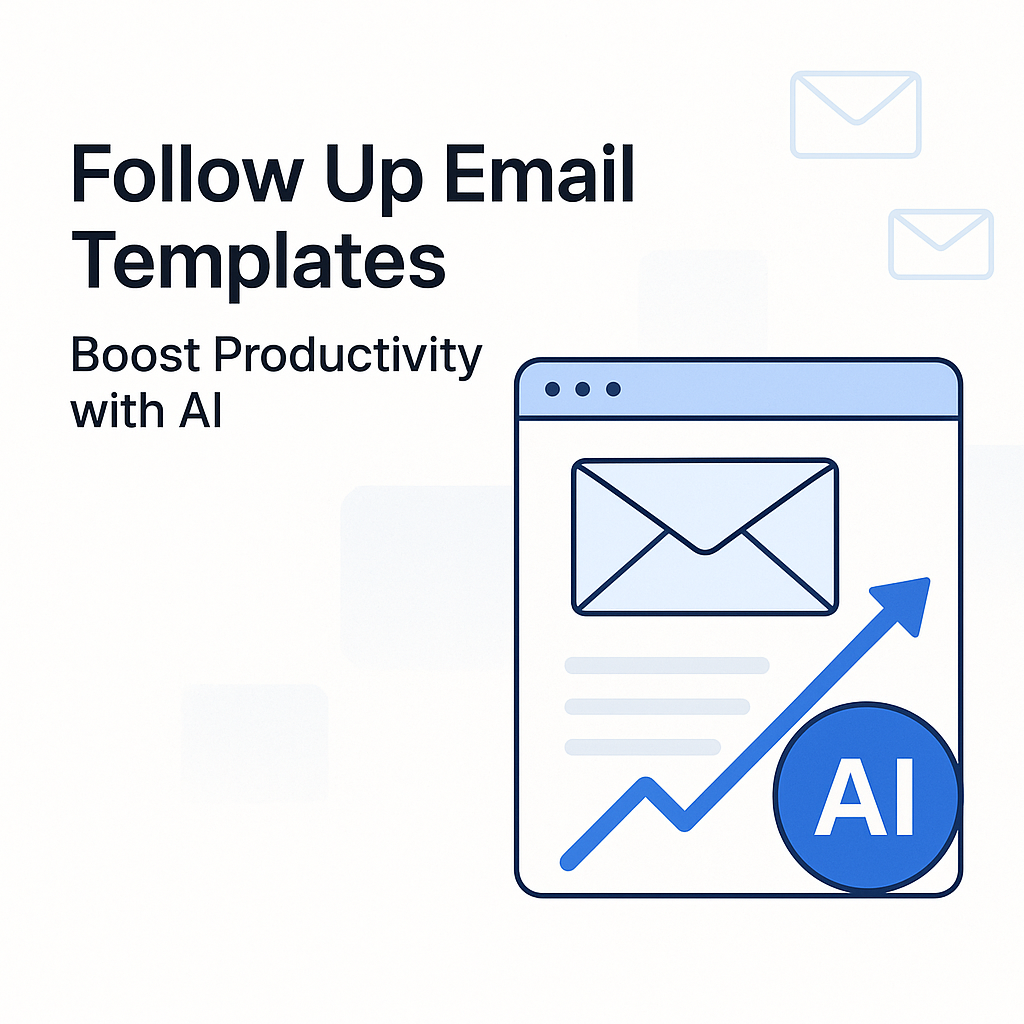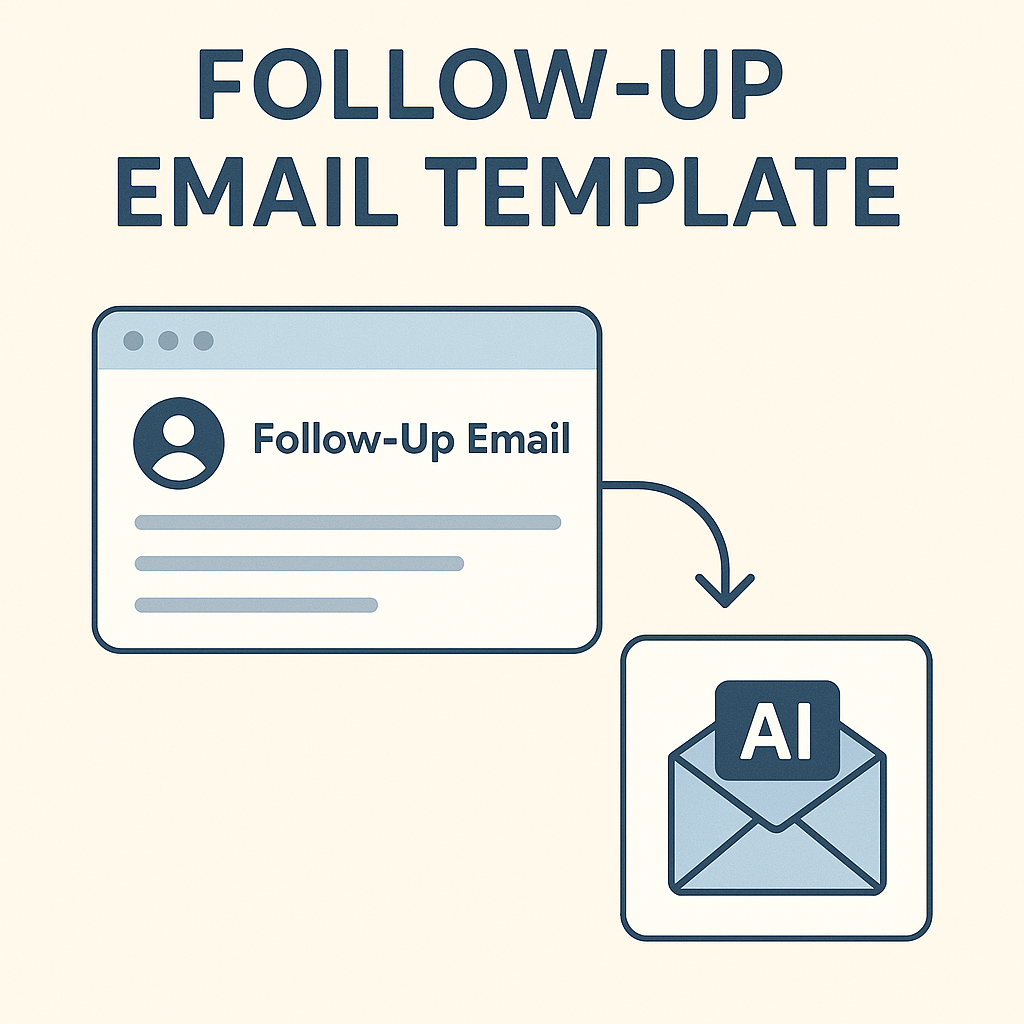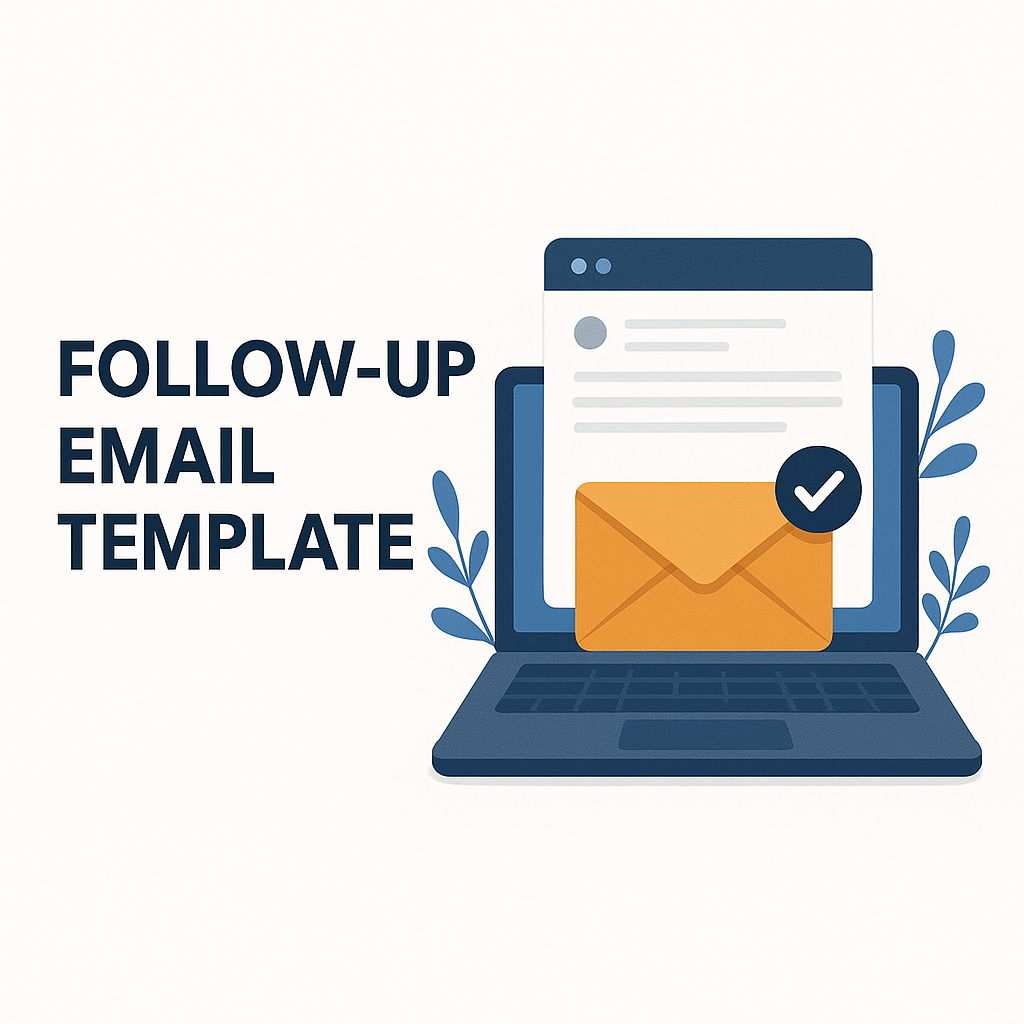Follow Up Email Templates: Boost Productivity with AI

The digital age has transformed business communication, but it has also created an inbox tidal wave. Every day, professionals sift through dozens, if not hundreds, of emails, making it challenging to stay on top of critical tasks and relationships. In this bustling environment, a well-crafted follow-up email isn't just a courtesy; it's a strategic imperative. It's the key to unlocking opportunities, securing commitments, and ensuring your messages don't get lost in the digital noise. Mastering the art of the follow up email template can significantly boost your email productivity and improve overall inbox management. But in a world where attention spans are fleeting and inboxes are overflowing, simply sending a generic follow-up often isn't enough. This is where the power of Artificial Intelligence steps in, promising to revolutionize how we handle these essential communications.
Why Standard Follow-Ups Aren't Enough: Addressing Inbox Overload
The sheer volume of emails we receive daily can be paralyzing. Studies show that the average professional receives over 120 emails per day, and many spend a significant portion of their workday just managing their inbox. This constant influx creates a breeding ground for missed messages, forgotten tasks, and a general sense of being overwhelmed. Generic business email templates, while a starting point, often fail to cut through the clutter. They lack the personalization and context that grabs attention and prompts a response. Sending follow-ups manually, especially across multiple channels or to numerous contacts, consumes valuable time and mental energy. This process is not only inefficient but also prone to errors, such as forgetting to follow up altogether or sending a message that's irrelevant to the recipient's current situation. If you're struggling to keep your inbox under control, exploring strategies like Gmail inbox cleanup can be a great first step, but the real game-changer lies in smarter, more automated approaches.
Leveraging AI for Smarter Follow-Ups: Introducing Autonomous Agents
The evolution of Artificial Intelligence has brought us sophisticated tools capable of much more than simple automation. Think of AI email assistants and autonomous agents as your digital team members, designed to handle repetitive and time-consuming tasks with remarkable efficiency. These AI-powered systems can analyze your communication patterns, understand context, and even predict what needs to be done next. For follow-ups, this means AI can:
- Identify emails that require a follow-up.
- Draft personalized messages based on previous interactions.
- Schedule these messages for optimal delivery times.
- Track engagement metrics like opens and clicks.
- Even trigger subsequent actions based on recipient responses.
This level of email automation frees up professionals to focus on high-value activities that require human creativity and strategic thinking. By delegating the grunt work of follow up email template management and sending to AI, you can ensure consistent, timely, and effective communication without the manual overhead. This shift from manual to AI-driven email productivity is crucial for staying competitive and managing the complexities of modern business correspondence.
Essential Follow-Up Email Template Components for Maximum Impact
To create follow-up emails that get results, every component must be intentional. While AI can draft and send, understanding these core elements ensures the message is effective:
- Compelling Subject Line: This is your first impression. It needs to be clear, concise, and ideally, include a hint of urgency or benefit. Avoid generic subjects like "Following Up." Instead, try something like "Checking In: Your [Project Name] Update" or "Quick Question Regarding [Topic]."
- Personalization: Generic emails get ignored. Address the recipient by name and reference a specific detail from your previous interaction – a shared idea, a particular challenge discussed, or a piece of information you promised to send. As highlighted by Krisp.ai, a great follow-up includes clear next steps, and personalization ensures the recipient feels the message is relevant to them.
- Value Proposition: Why should they read this email? What's in it for them? Reiterate the benefit of your proposal, provide a useful update, or offer a solution to a problem they might be facing.
- Clear Call to Action (CTA): What do you want the recipient to do next? Reply with a specific piece of information? Schedule a call? Click a link? Make it unmistakable and easy to act upon. Saleshandy.ai suggests that every update needs a status check, and your CTA should facilitate that.
- Professional and Friendly Tone: Maintain a balance between professionalism and approachability. The tone should reflect your brand and your relationship with the recipient.
- Conciseness: Respect the recipient's time. Get straight to the point without unnecessary jargon or lengthy explanations.
- Proofreading: Even AI-generated content needs a human eye. Errors can undermine credibility. Ensure grammar, spelling, and context are perfect.
Customizable Follow-Up Email Templates for Common Scenarios
Having ready-to-use follow up email templates tailored for different situations can save immense time. Here are a few examples, designed to be easily adapted:
1. Post-Meeting Follow-Up
This template reinforces your discussion, clarifies action items, and sets expectations for moving forward.
- Subject: Following Up: [Meeting Topic] & Next Steps
Dear [Recipient Name],
It was a pleasure speaking with you today about [Meeting Topic]. I found our discussion on [Specific Point Discussed] particularly insightful.
As we discussed, the key action items are:
- [Your Action Item]: [Brief Description]
- [Recipient's Action Item]: [Brief Description]
- [Agreed Next Step]: [Date/Time]
I've attached [relevant document] for your reference. Please let me know if you have any questions or if there's anything else you need from my end before our next touchpoint.
Best regards,
[Your Name]
2. Sales Inquiry Follow-Up
This type of sales follow up email aims to nurture a lead and provide further value without being overly pushy.
- Subject: Checking In: Your [Product/Service] Inquiry
Hi [Recipient Name],
Hope you're having a productive week!
I wanted to follow up on your inquiry about [Product/Service]. I recall you were particularly interested in how it could help with [Recipient's Pain Point].
To give you a clearer picture, I've put together a brief case study on how a similar company, [Client Name], achieved [Specific Result] using our solution. You can find it here: [Link to Case Study].
Would you be open to a quick 15-minute call next week to discuss how [Product/Service] can specifically benefit [Recipient's Company Name]? Please let me know what time works best for you.
Sincerely,
[Your Name]
[Your Title]
3. Job Application Follow-Up
A polite nudge after applying for a role can show continued interest.
- Subject: Following Up: [Job Title] Application - [Your Name]
Dear [Hiring Manager Name],
I hope this email finds you well.
I am writing to follow up on my application for the [Job Title] position, which I submitted on [Date of Application]. I remain very interested in this opportunity and am excited about the possibility of contributing to [Company Name].
My skills in [Skill 1] and [Skill 2], combined with my experience in [Relevant Experience], align well with the requirements outlined in the job description. I am eager to learn more about the next steps in the hiring process.
Thank you for your time and consideration.
Sincerely,
[Your Name]
4. Networking/Information Request Follow-Up
When you've connected with someone for advice or insights.
- Subject: Quick Follow-Up: [Your Name] & [Networking Contact Name]
Hi [Networking Contact Name],
It was great connecting with you at [Event/Platform] last week. I really appreciated your insights on [Topic Discussed].
As promised, I wanted to follow up on my question regarding [Specific Question]. I'm currently exploring [Your Project/Goal], and any guidance you could offer would be invaluable.
If you have a moment, would you be able to share any thoughts or resources on this? No pressure at all if you're busy.
Thanks again for your time and willingness to connect.
Best,
[Your Name]
5. Follow-Up on Unanswered Email
A gentle reminder for emails that haven't received a response.
- Subject: Gentle Follow-Up: [Original Subject Line]
Hi [Recipient Name],
Hope you're having a good week.
I wanted to gently follow up on my previous email regarding [Briefly mention the topic]. I understand you're busy, so I've also included the key details below for your convenience.
[Paste key details from original email here]
If this isn't the right time or if there's someone else I should be speaking with, please let me know.
Thanks,
[Your Name]
These templates serve as excellent starting points. The power of email automation tools can help you manage these efficiently, ensuring you never miss a crucial follow-up and can even automate sequences of these messages. For businesses looking to streamline their communication, exploring options for email follow up automation is key.
How AI Personalizes and Automates Your Follow-Up Emails
The true magic of AI in follow up email template management lies in its ability to personalize and automate at scale. AI tools can go far beyond simple mail merges:
- Hyper-Personalization: AI can analyze a recipient's past interactions, engagement history, and even publicly available data (like LinkedIn profiles) to tailor messages with remarkable precision. It can suggest relevant content, reference shared interests, and adjust the tone to match the recipient's likely preferences.
- Intelligent Scheduling: AI can learn optimal times to send emails for individual recipients or segments, increasing the likelihood of an open and response. This moves beyond guesswork to data-driven decisions.
- Automated Sequences & Cadences: AI can manage complex follow-up sequences, automatically sending the next email in a series based on whether a previous one was opened, clicked, or replied to. This ensures consistent nurturing of leads or relationships.
- Content Generation & Refinement: AI assistants can draft initial follow-up emails, suggest subject lines, and even rephrase content to be more impactful or concise. Tools like WriteMail.ai emphasize providing clear goals to AI so it can tailor responses effectively.
- Action Item Extraction: As noted by Krisp.ai, AI can automatically extract action items from meeting notes or email threads, ensuring that follow-up tasks are clearly defined and assigned, which is critical for effective email action items.
- Predictive Analytics: Some advanced AI can predict which leads are most likely to convert or which follow-ups are most likely to succeed, allowing you to prioritize your efforts.
By integrating these capabilities, AI acts as a powerful AI email assistant. Modern tools, such as an ai executive assistant, can integrate with your inbox to manage these automated sequences, personalize content based on recipient data, and even suggest optimal send times, significantly boosting your overall email productivity. This allows for sophisticated email automation that was previously only possible with extensive manual effort.
Best Practices for Sending Follow-Up Emails with AI Assistance
While AI tools offer incredible power, effective follow up email template usage still requires strategic human oversight. Here are some best practices to maximize your results:
- Define Clear Objectives: Before sending any follow-up, know exactly what you want to achieve. Is it a response, a meeting, a sale, or simply maintaining a connection? AI can help execute, but human strategy sets the direction.
- Know Your Audience: Even with AI personalization, ensure the tone and content align with your relationship with the recipient. A first-time contact requires a different approach than a long-term client.
- Timing is Crucial: AI can help optimize send times, but understanding your industry and recipient's typical schedules is also important. Avoid sending follow-ups too soon or too late. Consider the context of your previous interaction.
- Keep it Concise and Valuable: Respect the recipient's time. AI can help condense information, but always review to ensure clarity and relevance. Every email should offer value, whether it's information, a solution, or a clear next step.
- Personalize Beyond the Name: While AI handles data, add a human touch. A genuine observation or a shared anecdote can make a significant difference.
- Review and Refine AI Outputs: AI is a tool, not a replacement for critical thinking. Always proofread AI-generated content for accuracy, tone, and appropriateness.
- Track and Analyze Performance: Use the analytics provided by your email tools to understand what works. Which subject lines get more opens? Which CTAs lead to more responses? Use this data to refine your follow up email templates and AI strategies. This continuous improvement is key to workflow optimization.
- Integrate with Your CRM: For sales and business development, ensuring your follow-up system integrates seamlessly with your Customer Relationship Management (CRM) software is vital for a holistic view of customer interactions.
Conclusion: Boosting Productivity with AI-Powered Follow-Up Strategies
In the relentless pace of modern business, effective follow up email templates are not a luxury, but a necessity for sustained growth and strong relationships. By embracing AI, professionals can transform the often-dreaded task of follow-up into a streamlined, efficient, and highly effective part of their communication strategy. From intelligent personalization to automated email sequences, AI tools empower you to manage your inbox, nurture leads, and stay top-of-mind without sacrificing valuable time. Tools like an AI email assistant can help streamline your workflow, ensuring that every crucial connection is maintained and every opportunity is pursued. By integrating AI-powered strategies and leveraging smart business email templates, you can significantly enhance your email productivity, reduce inbox management stress, and ultimately, drive better business outcomes. Start exploring AI solutions today and reclaim your inbox, one smart follow-up at a time.



